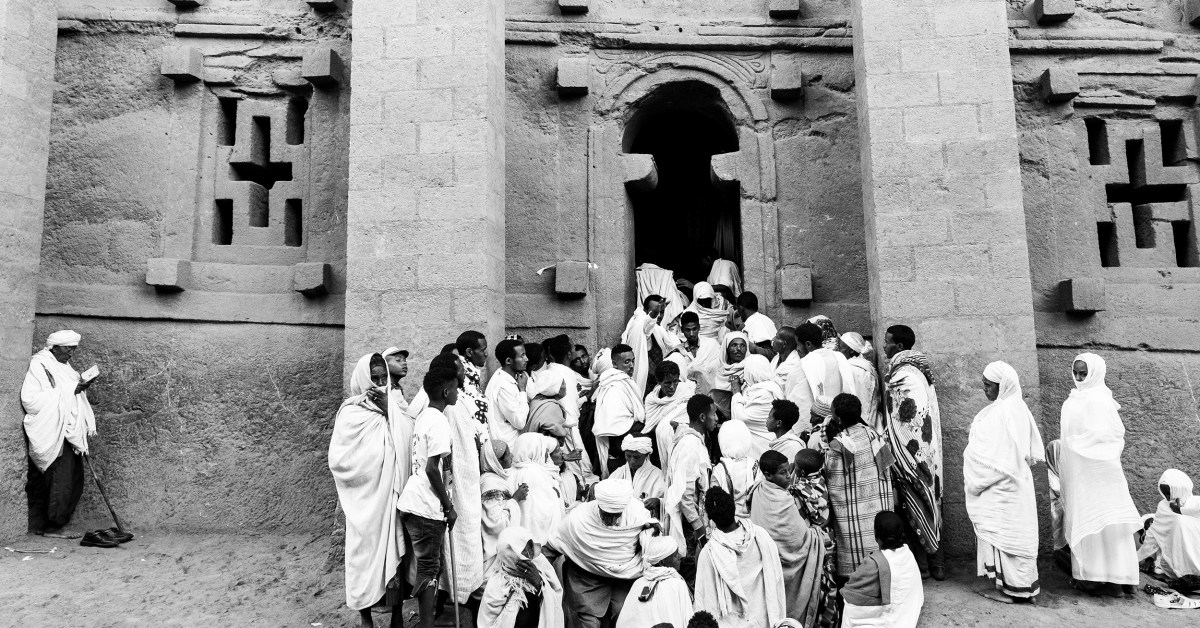Advancing the stories and ideas of the kingdom of God.
Photo essay by Andrew Faulk
A photo essay highlights thousands of pilgrims observing Christmas in the quiet highland town of Lalibela.
Pilgrims make their way in and out of Biete Medhane Alem (House of the Saviour of the World), the largest of the monolithic churches in Lalibela.
Each January, as Christmas is observed on the Ethiopian Orthodox calendar, the population of the quiet highland town of Lalibela swells with thousands of pilgrims. They arrive from farming villages, market towns, bustling cities, and distant provinces—some walking for days or weeks along dusty roads and others arriving by bus before climbing the last steep miles on foot. All come for Genna, the celebration of Christ’s birth, and to worship at one of Ethiopia’s most revered holy sites.
Lalibela’s medieval churches, carved directly from volcanic rock in the 12th and 13th centuries under King Lalibela, were created as a “new Jerusalem” for those unable to travel to the Holy Land. Each is hewn as a monolith, and they are connected by narrow passageways, trenches, and dimly lit tunnels. The most iconic, Biete Ghiorgis, takes the form of a cross cut deep into the earth—its walls descending into shadow while its roof levels with the surrounding ground.
In the cool mountain air, pilgrims wrapped in white cotton shammas press into the complex’s winding entrances. They bow to kiss stone thresholds, kneel on uneven floors worn smooth by centuries of devotion, and gather in candlelit chambers where chants echo off carved walls. The rituals are both communal and personal—moments of reverence link them to prior generations.
Get the most recent headlines and stories from Christianity Today delivered to your inbox daily.
This site is protected by reCAPTCHA and the Google Privacy Policy and Terms of Service apply.
Thanks for signing up.
Explore more newsletters—don’t forget to start your free 60-day trial of CT to get full access to all articles in every newsletter.
Sorry, something went wrong. Please try again.
For many, the pilgrimage is a rare journey away from the demands of life, a chance to gather with family, friends, and strangers in shared worship. Here, the Christmas story is not only told and preached from the mountainsides but also felt—in stone, in song, and in the footsteps of faith.
Interview by David Neff
Jocelyn O’Leary
Brad East
Carving Out Faith
Full Screen
1 of 5
Photo by Andrew Faulkk
The distinct cruciform structure of Biete Ghiorgis is one of 11 churches around Lalibela that are part of the UNESCO World Heritage Site.
Full Screen
2 of 5
Full Screen
3 of 5
Full Screen
4 of 5
Photo by Andrew Faulk
Pilgrims navigate between the monolithic church sites in Lalibela through narrow passageways hewn from volcanic rock.
Full Screen
5 of 5
Photo by Andrew Faulk
Pilgrims make their way in and out of Biete Medhane Alem (House of the Saviour of the World), the largest of the monolithic churches in Lalibela.
As we enter the holiday season, we consider how the places to which we belong shape us—and how we can be the face of welcome in a broken world. In this issue, you’ll read about how a monastery on Patmos offers quiet in a world of noise and, from Ann Voskamp, how God’s will is a place to find home. Read about modern missions terminology in our roundtable feature and about an astrophysicist’s thoughts on the Incarnation. Be sure to linger over Andy Olsen’s reported feature “An American Deportation” as we consider Christian responses to immigration policies. May we practice hospitality wherever we find ourselves.
View issue
Kyle Dugdale
Review
Matt Reynolds
Matthew Hirt
News
Daniel Silliman
Lanier Ivester
Review
John G. Turner
Review
Rick Ostrander
Review
Brian Key
Text by Ann Voskamp and Photos by Esther Havens
Russell Moore
Testimony
Franco Iacomini
Mark D. Bjelland
Qualms & Proverbs
Karen Swallow Prior, Kevin Antlitz, and Kiara John-Charles
Kate Lucky
View issue
View All
Public Theology Project
Russell Moore
Tucker Carlson hosted neo-Nazi Nick Fuentes on his podcast. The stakes are high for American Christians.
Isabel Ong
Three experts discuss whether the popular concept has a future in missions discourse.
Andy Olsen
A Colombian couple prayed with neighbors and raised their children in one of America’s most influential churches. What did we gain from their deportation?
Nicole Massie Martin
A letter from Mission Advancement in our November/December issue.
Chris Howles
UK mission mobilizer wants to rethink “unreached people groups” amid changing migration patterns and a digitally-connected world.
Deborah Haarsma
The heavens declare the glory of God in the person of Jesus Christ.
Kirsten Sanders
Our therapy culture has made us too comfortable with God.
Samuel Law
Singapore-based missiologist argues that the term “unreached people group” is a misnomer and can feed a romanticized notion of missions.
You can help Christianity Today uplift what is good, overcome what is evil, and heal what is broken by elevating the stories and ideas of the kingdom of God.
© 2025 Christianity Today – a 501(c)(3) nonprofit organization
“Christianity Today” and “CT” are the registered trademarks of Christianity Today International. All rights reserved.
Seek the Kingdom.
